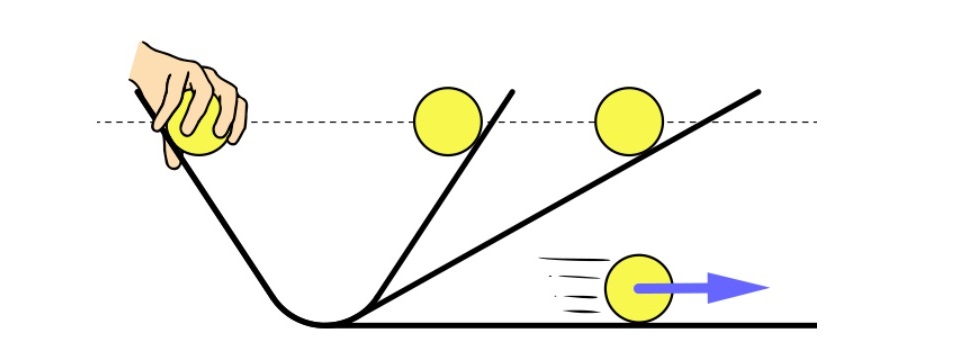
Having studied physics for nearly half a century, I still thought that Newton discovered all of his three laws. That was until recently, when I got curious about how he discovered them and started looking on Google.
Then I found to my surprise that Newton did not discover the first law that was named after him. Galileo apparently got the credit:
“ Before Galileo it had been thought that all horizontal motion required a direct cause, but Galileo deduced from his experiments that a body in motion would remain in motion unless a force (such as friction) caused it to come to rest. This law is also the first of Isaac Newton’s three laws of motion.” (britannica.com)

But why could it not be Gallileo who learnt about the law from Newton? Because Galileo died 11 months before Newton was born.
At first sight, the law looks simple and obvious. What is so special about it?
More importantly, why do students often get questions on the 1st law wrong?
The second question is actually quite simple to answer – because students often use their everyday feeling to think of a question, and do not use physics laws.
A simple example will show this. If you give a book on your table a push, it would move for a bit, slow down, and stop. If yo push harder, it would move a bit further, but would still slow down and stop.
This everyday observation has become part of our instinct. Deep in our mind is the idea that “a body in motion would remain in motion” is NOT possible.
Surely, if you give a book a slight push on the table, the book would move for a bit and stop.
You can see the struggle we have to go through to switch to a “physics” way of thinking. The fact that physics is correct, real and the truth makes little difference.
To most people – myself included – it is like an alternate reality. How can we reconcile this first law with our own experience?
I suppose this is the part where we call “understanding” or “explaining” comes it. This is also the kind of things that physics questions like to ask:
If Newton’s first law is true, why do moving objects always stop – at least things that we push.
To explain this, we need to think of a reason. This is where my students often stumble. I have seen students who start imagining various reasons.
The trouble is, most of these reasons they come up with are not related to laws of physics.
Going back to the book-on-table example - if Newton’s first law is true, why does the book not continue to move?
To answer this question in a “physics way”, we need to think in a “physics” way also. This means that the reasons we give in an answer must be related to some laws of physics.
This means we cannot just use an everyday example we have seen to answer this question. If we do, then all we can say is : “Of course it stops. It always stops!”
The “physics way” to think of the question goes something like this :
- When we give a book on a table a push, it moves for a short time and then stop.
- The first law says that a body will stay at rest or continue moving unless a force acts on it.
- Since the book does not continue moving, that must mean there is a force!
- Friction!
This is how we think using physics :
– always refer to the laws,
- use the laws to suggest possible answers,
- think about which answer is more likely.
Every one of the above steps needs practice :
- to remember and understand the laws,
- to know examples that can suggest answers,
- to have enough practice to be able to tell the right answer quickly.
On google, we can find various accounts on the origin of Newton’s first law from Galileo. The following figure is a good example.

Galileo is known to have done experiments with inclined planes. He knew that a ball rolling down a slope could roll up another slope to the same height, whether the second slope is steeper or more gentle.
(My guess is that he must have chosen slopes that were quite short for his experiments. Otherwise, frictio would have caused the ball to stop earlier.)
So he reasoned that if the second “slope” is horizontal, the ball would keep going if there is no force (like friction?) to stop it. This is basically Newton's first law.
From this history, we also learn that Newton’s 1st law was not discovered by Newton himself - since since Newton was born the year Galileo died.
Notice in the above examples – book on table, ball on slope – that Newton’s 1st law is deduced from various experiments, and not directly observed.
This is usually the case for laws in physics. It is a curious situation that physical events follow laws are usually difficult to observe.
In the case of Newton’s first law, as we see in the example above, the main reason why it is difficult to see its effect in real life is because friction is everywhere.
So it is very unlikely that no force is acting on an object.
But it is possible to find or create situations where the effect of any force on an object is relatively small.
Some examples :
- Pushing a book on a table with our hand at constant velocity. The force from our hand cancels the frictional force and we end up with an effectively no force situation.
- A bullet or comet moving at very high speed – before it hits something. Effect of gravity and air resistance is small over short distances.
So, what is so special about the first law?
- It is special because it is something that we can cannot normally see directly with our own eyes.
-And together with the second and third laws, they can be used to calculate all sorts of motion very accurately.
You can learn these concepts and more at Dr Hock's maths and physics tuition.